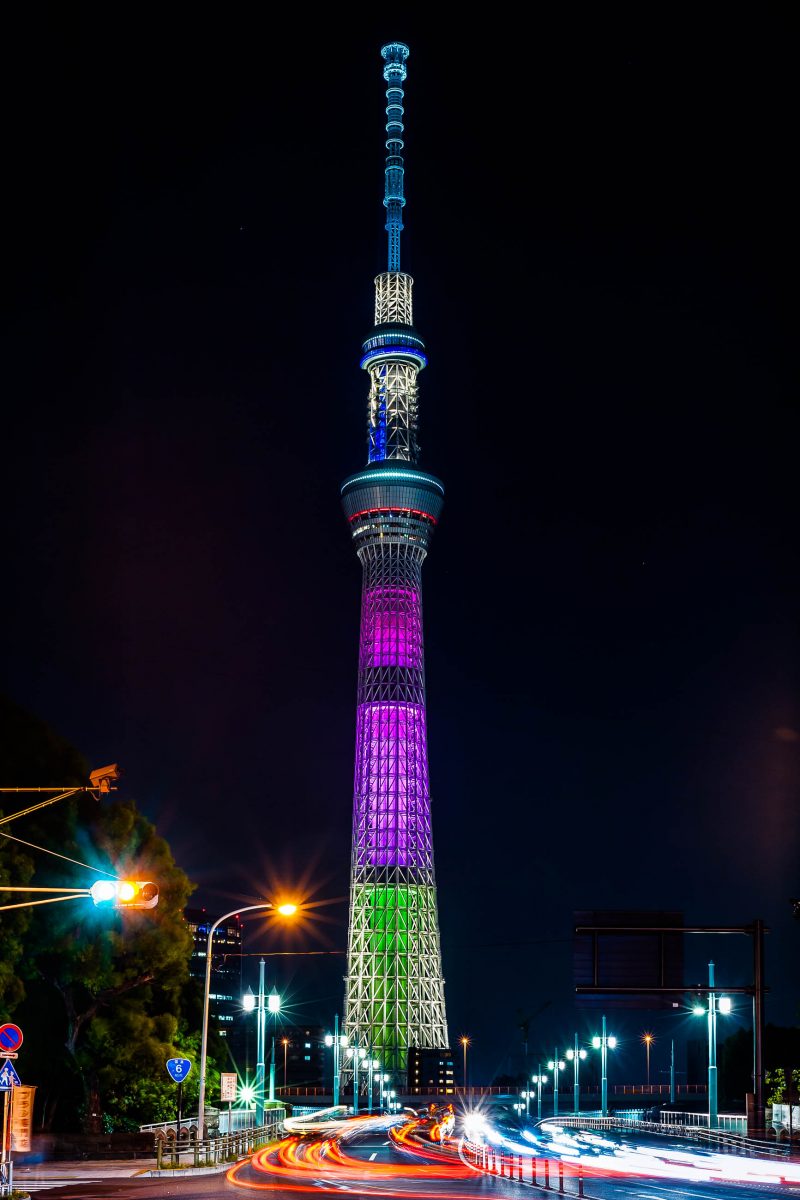Der Skytree ist seit 2012 nicht nur der neue Fernsehturm, sondern auch das neue Wahrzeichen der japanischen Hauptstadt Tokio. Die Japaner sind stolz, den höchsten Fernsehturm der Welt ihr Eigen nennen zu können und der Skytree ist dementsprechend gut besucht.
Der Skytree in der japanischen Hauptstadt Tokio ist mit einer Höhe von 634 Metern der höchste Fernsehturm und nach dem Burj Khalifa in Dubai das zweithöchste Bauwerk der Welt. Er ragt im Stadtteil Oshiage weit über das Häusermeer von Tokio hinweg und ist fast doppelt so hoch wie der 333m hohe Tokyo-Tower, das bisherige Wahrzeichen Tokios im Stadtbezirk Minato. Der elegante Turm zählt zu unseren Top 10 Sehenswürdigkeiten von Japan.
Der Skytree wurde am 22. Mai 2012 eröffnet und verdrängte damit – sehr zur Freude der Japaner – den Canton Tower in der chinesischen Stadt Guangzhou vom Platz des höchsten Turms der Welt.
Errichtung des Tokio Skytree
Der Skytree wurde als neuer Fernsehturm Tokios errichtet, denn der alte Tokyo Tower, der mittlerweile von einigen Wolkenkratzern umgeben ist, konnte eine vollständige Signal-Abdeckung der Stadt nicht mehr gewährleisten.
Das Design des Skytree wurde Nekken Sekkei Ltd., Japans ältestem Architekturbüro, übertragen. Baubeginn erfolgte am 14. Juli 2008, gut ein Monat nach Bekanntgabe der Bezeichnung des Turms, die durch eine Umfrage ausgewählt wurde. Nach nicht einmal vier Jahren Bauzeit wurde der Skytree am 29. Februar 2012 fertiggestellt.
Zur Erdbebensicherung wurden Methoden verwendet, die von Japans buddhistischer Pagoden-Architektur inspiriert wurde, denn in der gesamten Geschichte Japans ist noch keine Pagode durch ein Erdbeben eingestürzt. Mit dieser Technologie kann die Kraft der Erdstöße um 50% verringert werden.
Die Höhe des Skytree wurde übrigens nicht zufällig gewählt. Die Zahlen 6, 3 und 4 lauten im Japanischen „mu-sa-shi“, dies ist der Name einer ehemaligen Provinz, die einst Tokio, Saitama und Teile der Kanagawa-Präfektur umschloss. Der Skytree stellt damit ein echtes Wahrzeichen der Region dar.
Die Finanzierung der gut 800 Millionen US-Dollar wurde zum Großteil von der Tobu-Bahngesellschaft übernommen werden, auf dessen ehemaligen Rangierbahnhof der gewaltige Turm entstand. Ebenfalls beteiligt waren sechs Fernseh- und Rundfunksender, die den Skytree nutzen.
In der Nacht wird der Skytree von tausenden LEDs in wechselnden Farben beleuchtet. Die Lichter, die sich Mini-Meteoren gleich über den Aussichtsplattformen bewegen, stehen für den Lauf der Zeit und die Verbindung von Vergangenheit und Zukunft. Die Lichter an der Spitze strahlen scheinbar bis in den Weltraum und symbolisieren Träume und Hoffnungen.
Besuch des Tokio Skytree

Bei Eröffnung des Skytree waren die Tickets für einen Besuch in den ersten beiden Monaten sofort ausgebucht. Allein ein der ersten Woche waren es unglaubliche 1,6 Millionen! Bereits eine Woche vor der Eröffnung stellten sich die Menschen für Tickets an.
Der Besucherandrang ist mittlerweile nicht mehr ganz so hoch, mit Wartezeiten muss jedoch immer gerechnet werden. Die gläsernen Decken in den Hochgeschwindigkeitsaufzügen im Skytree erlauben während der rasanten Fahrt einen Blick nach oben.
Der Skytree ist mit zwei Aussichtsplattformen auf 350m (für 2.000 Besucher) und auf 450m (für 900 Besucher) ausgestattet. In einer gläsernen Wendeltreppe können die letzten 5 Meter bis zum höchsten Punkt der Aussichtsplattform erklommen werden. Die fantastische Aussicht von dort oben kann man sich kaum vorstellen. An klaren Wintertagen ist in der Ferne sogar der gut 100km entfernte Mount Fuji auszumachen.
Durch den Glasboden fällt der Blick auf die Straßen – mehrere hundert Meter in die schwindelerregende Tiefe. Für Notfälle ist der Skytree auch mit einer Treppe ausgerüstet – 2.523 Stufen führen bis nach oben.
Für die Wartezeit auf eine Fahrt nach oben steht eine große Shopping Mall am Fuß des Skytree zur Verfügung.
Weiterführende Links:
Offizielle Website des Skytree in Tokio mit Tickets und Öffnungszeiten





